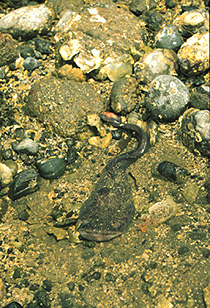Brain neurochemicals tell a female to act like a female, not her gender, Cornell biologists discover
By Roger Segelken

Cornell University biologists have shown how chemicals produced in a core region of the brain shared by all vertebrate animals (including humans) make males act like males, females like females -- and some males something like females.
James Goodson and Andrew Bass, who studied a fish species that produces two types of males for their report in the Feb. 17, 2000, issue of the journal Nature, say that brain processes responsible for social behavior typical of females, for example, aren't necessarily linked to the female's sex at all.
"This is a clear demonstration of how the action of neurochemicals can modulate the electrical or neurophysiological output of the brain as it establishes a social behavior," said Bass, professor of neurobiology and behavior, in an interview.
"We have also shown that there can be a neurochemical dissociation -- an uncoupling -- between an animal's gonadal sex and the regulation of behaviors typical of a sex," said Goodson, a postdoctoral fellow in Bass' neurobiology laboratory.
The part of the brain studied by Goodson and Bass is the preoptic area-anterior hypothalamus, a section of the basal forebrain, which neurobiologists say has been "conserved" throughout the evolution of vertebrates. The functions and structure of this conserved brain region are strikingly similar in fish, amphibians, reptiles, birds and mammals, including humans. The neurochemicals credited with sex-related social behaviors are isotocin and vasotocin in fish and are essentially the equivalents of oxytocin and vasopressin, respectively, in mammals.
The fish that made the neurochemical finding possible is the plainfin midshipman (Porichthys notatus), best known for its singing in shallow salt water at mating time. Most of the noise comes from male midshipman fish of the type I variety, which vocalize for hours under rocks to attract females. When type I males' courtship songs are successful, females briefly visit the nests to deposit eggs, then leave the type I males to fertilize the eggs and raise the young.
Sometimes, however, the type I males' songs have an unintended effect, attracting a different kind of male of the same species. Called type II or "sneaker" males, the visitors are distinguished by three things: Their inability to sing like a type I male (although type II males can grunt, as can females, which is explained in the attached fact sheet); their smaller body size but enlarged reproductive organs; and the type II males' habit of sneakily fertilizing eggs left for the type I males.

Also attracted to all the singing, grunting and sexual shenanigans are opportunistic biologists, eager to analyze an animal system with a third, intermediate gender -- the type II males -- and with behaviors that are linked to gender. Watching this salt opera, the Cornell biologists wondered: Are the gender-typical actions dictated by the animal's sex, as embodied in the gonads? Or can a brain process alone initiate gender-typical behavior?
Working in the laboratory with anesthetized type I males, type II males and female midshipman fish, the Cornell biologists first applied gentle electrical stimulation to nerve cells in the basal forebrain. That caused type I males to produce versions of their courtship songs and grunts, females to make their characteristic grunts and type II males to make the same, female-like grunts -- all in "fictive" form. (Fictive vocalizations are electrical impulses that are recorded from nerves controlling the fish's vocal muscles, much like the nerves that control vocal muscles of the human larynx. The fictive vocalizations are displayed on a computer and heard through a speaker; despite their electronic format, the recordings sound virtually identical to the natural sounds of free-swimming males and females.)
Next the biologists tested the effects of the neurochemicals by putting small amounts of each chemical into the basal forebrain, or by treating the fish with a chemical called an antagonist that blocks the animal's own neurochemicals from binding to nerve cells and influencing behavior. By comparing the effects of isotocin, vasotocin and their antagonists with the effects of a control substance similar to the fish's brain fluid, the researchers demonstrated that the neurochemicals decrease -- whereas the antagonists increase -- the amount of fictive vocalization that is recorded when the basal forebrain is stimulated.
However, females and the different types of male midshipman fish didn't all respond the same. The courting males (type I) were sensitive to vasotocin but not isotocin, and in females, this pattern was reversed. The sneaker males (type II), whose vocal behavior is more like females, exhibited responses to the chemicals that were almost identical to females, rather than other males.
The Cornell biologists have shown, for the first time in any animal species, that the neurochemical regulation of gender-typical behavior by the basal forebrain is not necessarily limited by an animal's gonadal sex, even though sexual behavior and the gonads also are regulated by this brain region. Writing in Nature, they offer "strong evidence that gonadal sex and social/reproductive tactics may be uncoupled from each other and regulated independently within the same brain region."
Goodson adds, "Apparently, the process of evolution has modified reproductive and social behavior independent of the gonads. This blending of characteristics should make more variation available for natural selection to act upon and may help explain the extraordinary range of social behaviors that we see across all of the vertebrate groups, from sex role reversal to dynamic diversity in the sex differences found for parental care and aggressive competition."
The study was supported, in part, by grants from the National Science Foundation. Logistical support was provided by the University of California Bodega Marine Laboratory.
Salt Opera Fish Facts: It's not over when the single father sings
Source: Department of Neurobiology and Behavior, Cornell University
- Among the three kinds of plainfin midshipman (Porichthys notatus) fish -- type I males, females and type II males -- only type I males sing. They perform their droning song to attract females to the rock nests where these soon-to-be single fathers hope to raise a family. Eggs deposited by females in the nests are fertilized and tended by type I males after the females depart.
- But the eggs also might be fertilized by type II males, a smaller male type that sneaks into nests to spawn.
- After a furtive attempt at fertilizing females' eggs, the type II males, like the females, depart and leave the nesting type I males to protect the eggs and newly hatched young. The so-called sneaker males and females don't produce the courtship song of type I males, but like the type I males, they do give brief grunts.
- These grunts are aggressive, and are used in different contexts by the different kinds of midshipman: Type I males grunt during fights to obtain the best nests, and while defending the eggs and young from usurpers; in contrast, type II males, like females, grunt mostly in non-reproductive social contexts, when they are hassled or are agitated.
- As a virtuoso single parent raising young that aren't all his, the type I male midshipman is a boon to biologists. His elaborate vocalizations are used much differently from the simple grunts of females and type II males, and Cornell biologists suspected that his brain must reflect the difference.
Media Contact
Get Cornell news delivered right to your inbox.
Subscribe